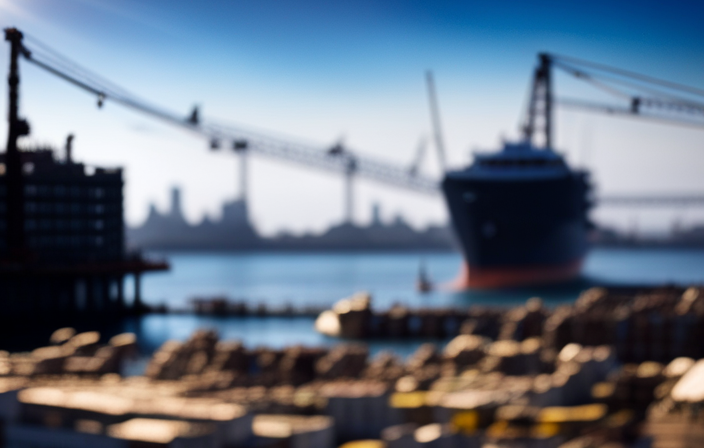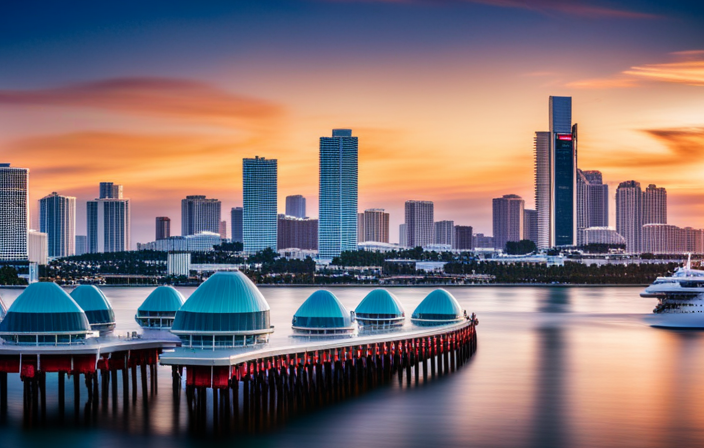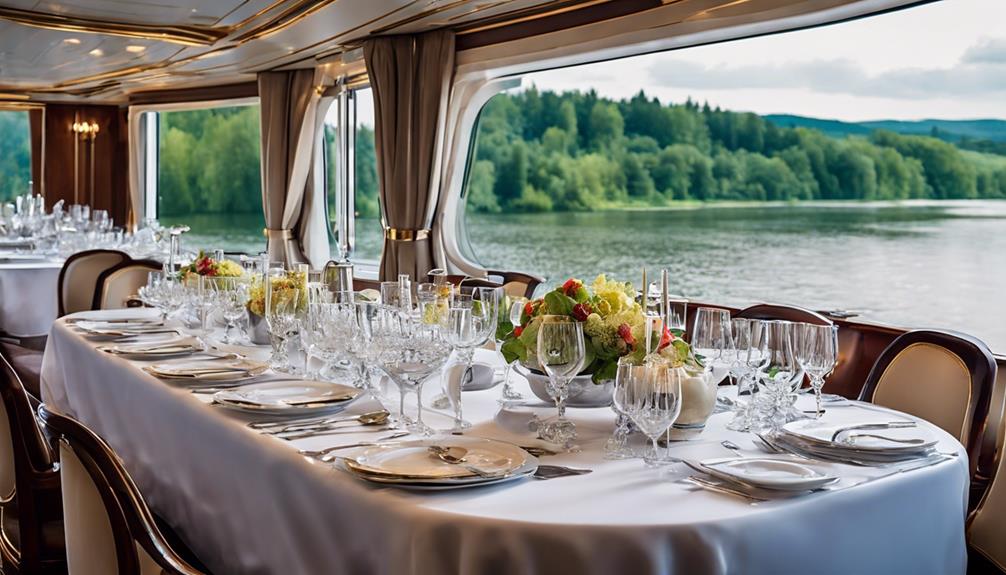Ever wondered about the beginnings of those massive maritime cities, commonly known as cruise ships? Get ready to be amazed, as the response is truly mind-blowing!
Cruise ships are not just constructed in ordinary shipyards; they are born in shipbuilding hotspots around the globe, where engineering marvels come to life.
In this article, we will take a fascinating journey through the process of building these magnificent vessels, exploring the largest cruise ship builders and the innovations that make them even more extraordinary.
We will also delve into the economic impact of cruise ship construction and get a glimpse into the future of this awe-inspiring industry.
So sit back, relax, and prepare to be enthralled by the secrets behind the creation of these incredible maritime wonders.
Key Takeaways
- Cruise ships are built in countries such as Germany, Italy, South Korea, and Finland.
- Shipbuilding techniques focus on innovation, efficiency, and the use of lightweight materials like aluminum and composites.
- Technology plays a crucial role in ship construction, with CAD software and robotic welding being commonly used.
- Sustainable practices are increasingly important in cruise ship building, with alternative energy sources like hybrid propulsion systems and LNG engines being utilized.
The Importance of Shipbuilding in the Cruise Industry
Shipbuilding is crucial in the cruise industry because it’s where dreams are brought to life, creating majestic floating palaces that transport us to extraordinary destinations. Shipbuilders employ various shipbuilding techniques and leverage advancements in naval architecture to construct these impressive vessels.
The cruise industry relies heavily on shipbuilding to continuously innovate and meet the demands of discerning travelers. Technological advancements in shipbuilding have allowed for the construction of larger, more luxurious ships, equipped with state-of-the-art amenities and facilities. These advancements include the use of lightweight materials, such as aluminum and composite materials, which enhance fuel efficiency and reduce environmental impact.
Shipbuilders also employ cutting-edge design software and simulation tools to optimize the ships’ performance and safety. Shipbuilding hotspots around the world play a crucial role in meeting the industry’s growing needs, fostering economic growth, and providing employment opportunities.
Shipbuilding Hotspots Around the World
Located in various regions across the globe, skilled craftsmen and cutting-edge technologies converge to create the impressive marvels that dominate the world’s oceans. Shipbuilding techniques have evolved over the years, with a focus on innovation and efficiency.
Some of the emerging shipbuilding markets include:
-
Germany: Known for its precision engineering and high-quality workmanship, German shipyards are renowned for their expertise in building cruise ships.
-
Italy: Italian shipyards specialize in luxury cruise ships, combining elegant design with state-of-the-art technology.
-
South Korea: With a strong emphasis on advanced technology, South Korean shipyards have become major players in the cruise shipbuilding industry.
-
Finland: Finnish shipyards are known for their expertise in ice-class cruise ships, designed to navigate icy waters with ease.
Transitioning into the next section, understanding the shipbuilding hotspots helps to shed light on the intricate process of building a cruise ship.
The Process of Building a Cruise Ship
Craftsmen and cutting-edge technologies from various regions across the globe converge to create impressive marvels that dominate the world’s oceans, showcasing the intricate process and expertise required to bring a cruise ship to life.
The role of technology in cruise ship construction cannot be overstated. Advanced computer-aided design (CAD) software allows for precise planning and modeling, while robotic welding and laser cutting ensure accuracy and efficiency in the construction process.
However, it’s important to consider the environmental impact of cruise ship building. The industry has made significant strides in implementing sustainable practices, such as using environmentally friendly materials and reducing emissions. Shipbuilders are also exploring alternative energy sources, such as hybrid propulsion systems and LNG (liquefied natural gas) engines. These efforts aim to minimize the ecological footprint of cruise ship construction.
Transitioning to the largest cruise ship builders in the world, their expertise and resources contribute to the creation of these floating giants.
The Largest Cruise Ship Builders in the World
With a little sprinkle of magic, these colossal floating wonders are conjured by the world’s most skilled wizards of the sea. The largest shipyards in the world take on the daunting task of constructing these massive cruise ships.
One of the leading shipbuilders is STX Europe, located in Turku, Finland. They’re known for their state-of-the-art construction techniques, including modular construction, where different sections of the ship are built separately and then assembled together.
Another major player in the industry is Meyer Werft, based in Papenburg, Germany. They have a reputation for their innovative engineering and use of advanced technology in shipbuilding.
These shipyards are constantly pushing the boundaries of what’s possible in cruise ship construction. As we delve into the next section about innovations in cruise ship design and construction, we’ll discover the secrets behind these extraordinary feats of engineering.
Innovations in Cruise Ship Design and Construction
One of the most remarkable advancements in the design and construction of these magnificent floating wonders is the implementation of cutting-edge technology. Cruise ship builders are constantly pushing the boundaries of innovation in ship design to create vessels that are not only larger and more luxurious, but also more environmentally friendly. Sustainable shipbuilding techniques are being incorporated into every aspect of the construction process, from the materials used to the energy systems installed on board. These innovations not only reduce the environmental impact of cruise ships, but also enhance the overall experience for passengers. For example, the use of advanced air conditioning and ventilation systems ensures a comfortable and healthy environment for everyone on board. As we delve further into the challenges and trends in cruise ship construction, we will explore how these innovations are shaping the industry’s future.
Challenges and Trends in Cruise Ship Construction
Amid the turbulent waves of progress, the endless horizon of challenges and trends in cruise ship construction stretches out like an uncharted sea. Shipbuilders face numerous challenges in constructing modern cruise ships, including the need for innovative and sustainable design solutions, meeting strict safety and environmental regulations, and managing the increasing complexity of onboard facilities and amenities.
To overcome these challenges, shipbuilders are embracing the latest trends in cruise ship construction. These trends include the use of advanced materials and technologies to enhance energy efficiency and reduce environmental impact, the incorporation of smart technology for improved guest experience and operational efficiency, and the adoption of modular construction methods for faster and more cost-effective shipbuilding.
As cruise ship construction continues to evolve, it has a significant economic impact on the global maritime industry. [Transition sentence to the subsequent section about the economic impact of cruise ship construction goes here].
The Economic Impact of Cruise Ship Construction
Imagine the excitement of witnessing the economic ripple effect that occurs when a new cruise ship sets sail, as countless jobs are created and local businesses flourish.
The economic benefits of cruise ship construction are undeniable. The construction of a single cruise ship can create thousands of jobs, not only in shipyards but also in the supply chain, as materials and equipment are sourced from various industries. In addition, the local economy experiences a boost as workers spend their wages on housing, food, and other necessities.
The impact is not only temporary, as ongoing maintenance and refurbishment of cruise ships also generate employment opportunities. Job creation is just one aspect of the economic benefits of cruise ship construction.
The industry also contributes to tourism revenue, as cruise ship passengers spend money on shore excursions, shopping, and dining. As we explore the future of cruise ship building, it’s clear that this industry will continue to play a significant role in job creation and economic growth.
The Future of Cruise Ship Building
The future of cruise ship construction is set to sail towards uncharted economic horizons, as the industry continues to innovate and captivate the market with its floating marvels.
-
Future trends: Cruise ship construction is expected to focus on enhancing passenger experiences through advanced technology, such as virtual reality and interactive entertainment options.
-
Sustainable construction: Environmental concerns are driving the industry to adopt more sustainable practices, including the use of eco-friendly materials and energy-efficient systems.
-
Energy innovations: Cruise ship builders are exploring alternative energy sources, such as LNG (liquefied natural gas) and fuel cells, to reduce emissions and improve fuel efficiency.
-
Design revolution: The future of cruise ship construction will witness groundbreaking designs, with architects and engineers pushing the boundaries of imagination to create unique and awe-inspiring vessels.
As we explore the fun facts about cruise ship construction, we will discover the remarkable achievements and fascinating trivia behind these engineering marvels.
Fun Facts About Cruise Ship Construction
Did you know that cruise ship construction involves a fascinating blend of artistry and engineering? When it comes to cruise ship materials, steel is the most commonly used due to its strength and durability. However, modern cruise ships are also incorporating lighter materials like aluminum to reduce weight and increase fuel efficiency.
Another interesting aspect of cruise ship construction is the consideration of size. Cruise ships are built to be able to fit through the Panama Canal, which limits their width to 106 feet. This constraint requires careful planning and design to maximize space and provide all the amenities passengers expect.
As we delve into the conclusion, a glimpse into the maritime engineering marvels awaits, showcasing the incredible feats of engineering and design that make cruise ships possible.
Conclusion: A Glimpse into the Maritime Engineering Marvels
Get ready to be amazed as you catch a glimpse of the awe-inspiring engineering marvels that bring these floating cities to life. Cruise ship construction has come a long way, with incredible advancements in maritime engineering and architectural design. These modern-day behemoths are built with cutting-edge technology, ensuring their safety, comfort, and efficiency.
One of the most impressive aspects of cruise ship construction is the innovative use of space. The design and layout of these ships are carefully planned to maximize every inch, providing passengers with a wide range of amenities and activities. From luxurious cabins to multiple dining options, theaters, swimming pools, and even ice rinks, cruise ships are like miniature cities on water.
To give you a better idea of the complexity and scale of these engineering marvels, here is a table showcasing some of the key features and advancements in cruise ship construction:
| Feature | Advancement |
|---|---|
| Safety systems | Advanced fire detection and suppression |
| Propulsion technology | LNG-powered engines |
| Energy efficiency | Solar panels and LED lighting |
| Environmental sustainability | Waste management systems |
These advancements in maritime engineering have revolutionized the cruise industry, making it possible for these floating cities to provide unforgettable experiences for millions of passengers around the world.
Frequently Asked Questions
How long does it take to build a cruise ship from start to finish?
It typically takes 2-3 years to build a cruise ship from start to finish. Challenges in construction include managing the large scale project, ensuring safety standards, and coordinating the installation of advanced technologies that enhance the passenger experience.
What are the main materials used in the construction of cruise ships?
In the construction process of cruise ships, the main materials used include steel, aluminum, and fiberglass. These materials are crucial for ensuring durability, stability, and safety, while also allowing for customization and luxurious amenities.
How do cruise ships differ from other types of ships in terms of design and construction?
Cruise ships differ from other ships in their design and construction through the use of innovative technologies. They incorporate advanced systems for navigation, entertainment, and comfort. Furthermore, environmental considerations are prioritized in their construction and operations to reduce their ecological impact.
Are cruise ships built in one location or are they assembled in different parts of the world?
Oh, the wonderful world of cruise ship construction! These floating giants are assembled in different parts of the globe, impacting local economies and environments. Technological advancements have revolutionized the assembly process, making it more efficient and precise.
How are cruise ships transported from the shipyard to the water?
Cruise ships are transported from the shipyard to the water using a variety of transportation methods. This includes floating out the ship, using tugboats, and sometimes even lifting the ship using a massive dry dock. The transportation process presents challenges such as maneuvering through narrow channels and ensuring the ship’s stability during the transfer.
Is Tampa a Common Location for Cruise Ships to be Built?
Yes, Tampa is one of the popular cruise ship docking locations in Tampa. The city has a thriving shipbuilding industry with several major shipyards that specialize in constructing cruise ships. Its strategic location and access to skilled labor make it an ideal place for new cruise ship construction.
Conclusion
In conclusion, cruise ship construction is a captivating combination of creativity and craftsmanship. The shipbuilding industry is a vital component of the cruise industry, with hotspots around the world where these maritime marvels are created.
The process of building a cruise ship involves intricate engineering and innovative design. The economic impact of this industry is substantial, generating jobs and revenue.
As we look to the future, advancements in shipbuilding techniques will continue to push the boundaries of what’s possible. So next time you embark on a cruise, appreciate the awe-inspiring ingenuity behind these floating palaces.
Meet Asra, a talented and adventurous writer who infuses her passion for exploration into every word she writes. Asra’s love for storytelling and her insatiable curiosity about the world make her an invaluable asset to the Voyager Info team.
From a young age, Asra was drawn to the power of words and their ability to transport readers to far-off lands and magical realms. Her fascination with travel and cultures from around the globe fueled her desire to become a travel writer, and she set out on a journey to turn her dreams into reality.











